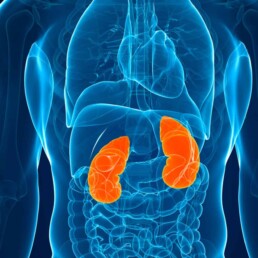Membranous nephropathy (MN) is a type of kidney disease that affects the glomeruli—tiny blood vessels in the kidneys responsible for filtering waste from the blood. In membranous nephropathy, the immune system mistakenly attacks these glomeruli, leading to thickening of the glomerular basement membrane (GBM). This thickening disrupts the kidney’s ability to filter blood properly, causing proteins to leak into the urine, a condition known as proteinuria. In this blog, we will discuss symptoms and causes of membranous nephropathy.
As usual, the references are in the hyperlinks.

By Majd Isreb, MD, FACP, FASN, IFMCP
What Causes Membranous Nephropathy?
The exact causes of membranous nephropathy are often unknown, making it difficult to predict who will develop the disease. However, MN can be categorized into two types based on its causes:
Primary Membranous Nephropathy
This is the most common form and occurs when the disease develops without an identifiable underlying cause. It’s thought to be an autoimmune condition where the body’s immune system mistakenly targets proteins in the GBM. In many cases, the specific antibodies responsible for this attack have been identified, such as the phospholipase A2 receptor (PLA2R) antibodies. Genetic predispositions plays a role here (see below) and even though scientists didn’t identify the exact trigger it is likely because it has not been linked to MN yet.
Secondary Membranous Nephropathy
- This form occurs as a result of another condition or external factor. Common causes of secondary membranous nephropathy include:
- Infections: Hepatitis B and C, syphilis, and malaria are known to trigger MN.
- Autoimmune Diseases: Conditions like systemic lupus erythematosus (SLE) can lead to MN.
- Medications: Certain drugs, including nonsteroidal anti-inflammatory drugs (NSAIDs), gold salts, penicillamine, and some monoclonal antibodies, have been linked to MN.
- Cancers: Some forms of cancer, particularly solid tumors like lung or colon cancer, have been associated with MN.
- Environmental Toxins: Exposure to certain toxins, such as mercury, can also cause the disease.
Join us to end the kidney disease epidemic
Symptoms of Membranous Nephropathy
The hallmark symptom of MN is proteinuria, where large amounts of protein are lost in the urine. This can lead to:
- Swelling (Edema): Most commonly in the legs, ankles, and feet, but it can also affect the face and hands.
- Foamy Urine: Due to the high levels of protein in the urine.
- Weight Gain: Often as a result of fluid retention.
- Fatigue: Caused by the loss of protein, which can affect energy levels and overall health.
- High Blood Pressure: As kidney function declines, blood pressure may increase.
Diagnosing Membranous Nephropathy
Diagnosis usually involves a combination of tests, including:
- Urinalysis: To detect protein in the urine.
- Blood Tests: To measure kidney function and levels of antibodies that may be causing MN.
- Kidney Biopsy: A small sample of kidney tissue is examined under a microscope to confirm the diagnosis and determine the extent of the damage. More recently, the commercial availability of phospholipase A2 receptor (PLA2R) antibodies tests almost eliminated the need for a kidney biopsy.
Conventional Treatment Options
The treatment for MN depends on the underlying cause, the severity of the disease, and the patient’s overall health. In cases of primary MN, treatment might focus on controlling symptoms and slowing disease progression, while secondary MN requires addressing the underlying condition.
- Medications: These may include:
- Immunosuppressants: To reduce the immune system’s attack on the kidneys.
- Corticosteroids: To decrease inflammation.
- ACE Inhibitors or ARBs: To control blood pressure and reduce proteinuria.
- Lifestyle Changes: Diet and exercise modifications may be recommended to help manage symptoms and improve kidney health.
- Treating the Underlying Cause: In cases of secondary MN, it’s crucial to address the root cause, whether it’s an infection, cancer, or medication.
Integrative Treatment Options
An integrative approach to managing MN would combine conventional medical treatments with complementary therapies to address the disease holistically. The goal would be to identify the root causes of MN, manage symptoms, slow or reverse disease progression, and support overall well-being. More on that in a future blog.
Prognosis and Long-Term Management
The outlook for people with membranous nephropathy varies widely. Some people experience spontaneous remission, where the disease improves on its own. Others may progress to chronic kidney disease (CKD) or even kidney failure, requiring dialysis or a kidney transplant. Long-term monitoring and management are essential to prevent complications and maintain kidney function.
Join us to end the kidney disease epidemic
Genetics of Membranous Nephropathy
Genetics plays a significant role in the development of membranous nephropathy, particularly in its primary form. Researchers have identified specific genetic markers that increase the risk of developing MN. One of the most notable genetic associations is with the HLA-DQA1 gene, which is involved in immune system regulation. Variations in this gene are linked to an increased likelihood of the immune system targeting the kidney’s glomerular basement membrane, leading to the thickening and damage characteristic of MN.
Additionally, the presence of autoantibodies against the phospholipase A2 receptor (PLA2R) on kidney cells is strongly correlated with genetic predisposition. These findings suggest that individuals with certain genetic backgrounds are more susceptible to the autoimmune processes that trigger membranous nephropathy, highlighting the importance of genetic factors in the disease’s onset and progression.
The Bottom Line on Membranous Nephropathy
Membranous nephropathy is a complex kidney disease with various causes and outcomes. Understanding the symptoms and causes of membranous nephropathy is crucial for managing the condition and improving quality of life. If you or someone you know is experiencing symptoms of MN, it’s important to seek medical advice early for proper diagnosis and treatment. With the right care and management, many people with MN can lead healthy lives.







